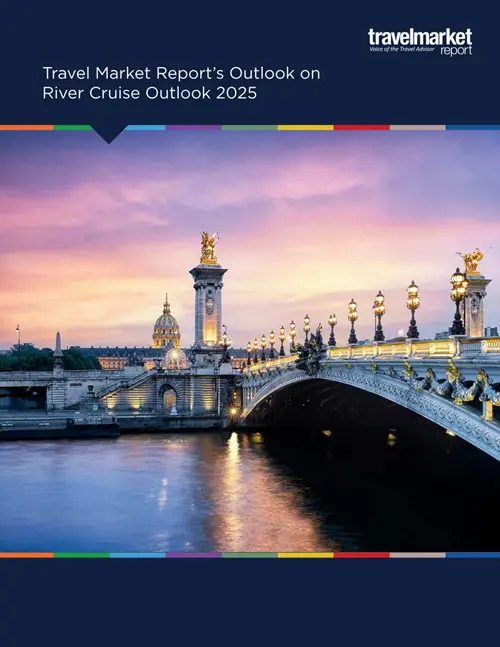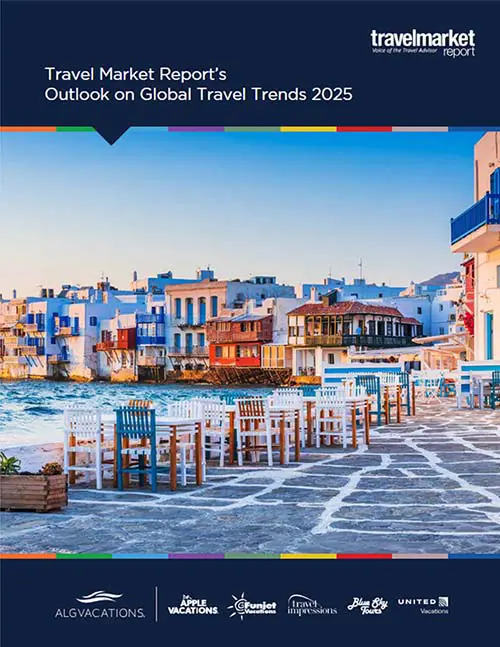The Baltics: A Saucy Romp and Fully Wired for Tourism
by Maria Lisella
The view from the tower of St. Olaf church, Tallinn, Estonia. Photo: Shutterstock.com
Two of them were listed in the New York Times’ 52 Places to Go in 2018. One of them is associated with the birth of Skype, while the third is one you don’t hear much about, but certainly will in 2018.
Just above Russia, and side by side with Scandinavia, the Baltics have often been add-ons to itineraries to Russia, Germany, Poland and Finland, but this year the region is showing up as a centerpiece.
Operator Busabout’s brochure describes the region as “scandalously sexy,” as Estonia, Latvia and Lithuania have more fashion models per capita than anywhere in the world, as well as kinky bars, nightclubs and historic tales that are adulterously engaging.
Estonia is a two-hour ferry ride from Helsinki; and there are great rail connections between Germany, Poland, Lithuania, Latvia and Estonia. Because the region was under the Soviet Union, it remained relatively undeveloped, and unspoiled for the past 50 years.
Among their commonalities is that all of their capital cities have been designated as UNESCO World Heritage sites.
Travel suppliers are moving in
International hotel brands are fast moving in. Hilton debuted its first property in the region, The Hilton Tallinn Park, Estonia in 2016, with plans to bring its midscale Hilton Garden Inn brand to Lithuania and Latvia. Likewise, Radisson has arrived in the region as has Kempinski.
Among other tour operators, Avanti Destinations has added Estonia, Latvia and Lithuania to its European lineup, so travel agents can combine them into customized multi-destination, independent itineraries for 2018.
“The Baltic nations make for a fascinating journey for clients looking to get off the usual European tourist path,” said Harry Dalgaard, Avanti’s president and CEO.
Insight Vacations sells two programs that visit the Baltics this year: the nine-day Warsaw and the Baltic States; and the 16-day Russia, Warsaw and the Baltic States.
Busabout has posted the eight-day Baltic Highlights as well as the 15-day Ultimate Scandi-Baltic, a hipster tour that includes lots of nightlife jaunts to the former meat-packing factories that now house nightspots and bars built of ice.
Sarna Rose, who owns and operates Poland Culinary Vacations, will be adding the Viking Homelands Baltic Cruise, combining Poland with the Baltics.
Avanti is offering a bonus commission of $50 for each booking of $1,500 or more made before Feb. 28, 2018 for off-season travel taking place through Mar. 31, 2018.
Among other operators featuring the Baltics this year are Abercrombie & Kent, Gate 1 Travel, Globus and Tauck World Discovery.
Estonia
With a population of about 1.4 million, almost 50 percent of Estonia is populated by forest, with more than 2,000 islands.
In February, Estonia will be celebrating the 100th anniversary of its founding with a cultural renaissance. The centerpiece is the new Estonian National Museum, a compellingly beautiful glass structure set on a former Soviet airbase runway in the city of Tartu.
Small Hotels of the World just announced that Estonia’s oldest property, the Hotel St. Petersbourg, has been given a complete makeover. Located in the heart of Tallinn’s old town with its pastel-hued merchant houses, gothic spires and winding cobbled streets, it is considered to be the best preserved medieval city in Northern Europe. The area’s dining scene is also attracting attention.
While Skype was founded back in 2003 by a Swede and a Dane, it was an Estonian who created the software that went live in 2003. Since then, Estonia has made its reputation on its astounding connectivity, a feature travelers are demanding more and more, no matter how remote the region.
Latvia
There’s a reason the country’s former tourism slogan was “Latvia – the land that sings.” It counts a million folk songs in its repertoire. Arguably the best time to witness this is the Song and Dance Celebration that takes place every five years and gathers 30,000 singers and dancers for a series of performances.
Riga is the largest city in the Baltics, distinguished for its world-class Art Nouveau in the New Town, while the streets buzz with cafes and bars and dining that includes haute cuisine for a fraction of the prices in the rest of Europe. The Old Town features Riga Castle, the Swedish Gate and its former Jewish ghetto.
Riga’s first five-star luxury property arrived in the fall of 2017 in the form of the Grand Hotel Kempinski, Riga. It was formerly the grand Hotel Riga that dated back to the 1880s, and housed the first-ever bar in Latvia. Some of the 141 rooms overlook the Freedom Monument and the nearby National Opera House.
Ten floors of the Park Inn by Radisson Riga Valdemara house 178 modern rooms, with views of the bridge across the Daugava River and a panorama of the Old Riga. The same property also houses a residential portion, Radisson Residence Riga Barona, making it the first and only apartment hotel chain in Riga.
Lithuania
While Lithuania’s statehood dates to the 13th century, this year it celebrates its 100th anniversary since restoring itself as an independent democracy.
Clients who follow their appetites may want to do a double take: Lithuania is in the midst of gastronomic revolution. Eight restaurant chefs in Lithuania’s three largest cities — Vilnius, Kaunas and Klaipeda — made the Baltic cream-of-the-crop in the widely respected Scandinavian White Guide 2018 for the second year running. And eight made it to the Baltic top 30 restaurants, with Nüman in Kaunas ranking third place.
Vilnius’ medieval and historic center, boutiques, churches and the Gothic castle on the nearby island of Trakai are worth visiting. Other highlights in Vilnius include the KGB Museum housed in the former KGB building, telling the story of the Soviet occupation from 1942-1990.
The southernmost of the Baltic countries, Lithuania, is most often linked to religious pilgrimages, and is a player on the Amber Route that also includes Poland. Amber was once used as currency and purportedly has medicinal properties as well.
























